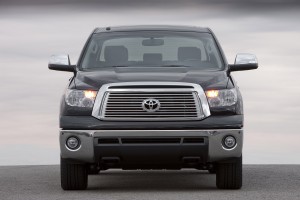
Toyota continues to plan for a next-gen Tundra and may look for new ways to build demand, whether with a heavy-duty model, diesels or even hybrids.
Though sale have fallen well short of Toyota’s initial goals, the industry giant remains “absolutely” committed to keeping the full-size Tundra pickup in its line-up, according to a senior company official.
In its bid to boost demand for the truck, “all options are on the table,” Group Vice President and Toyota Division General Manager Bob Carter tells TheDetroitBureau.com. That includes the long-rumored possibility of adding a heavy-duty model to the Tundra line. Could a hybrid also be in the offing?
“We are actively planning and developing” the replacement for the current Tundra, which Carter suggests may have simply been a victim of circumstance. The current model launched in 2007, just before gasoline surged to $4 a gallon in the U.S. for the first time and the subsequent economic crash. That led sales of full-size pickups, in general to drop to barely 1.1 million, off from the industry peak of 2.5 million.
“I will tell you we’re in the truck business for the long-term,” Carter stresses. That includes both full-size and compact pickups, even though many of the maker’s competitors are dropping out of the smaller truck segment. Ford, for example, is killing off its long-lived Ranger and has decided against bringing into the U.S. a new version recently launched in Thailand.
That’s good news for Toyota’s Tacoma, which currently has a 45% share of the compact pickup segment. An updated version, which will introduce front end changes most consumers will see as “a new truck,” according to Carter, will be launched in the States in October.
Toyota has had a far more difficult time cracking the big truck market ever since launching the original T-100 nearly two decades ago. The Tundra has barely clipped an 8% market share – which has been slipping in recent months despite being the only Toyota product supported by large, direct cash incentives. Tundra is one of four models produced by Toyota in the U.S. that is still facing limited capacity due to parts shortages caused by the March 11 Japanese earthquake. Some observers question whether that’s just an excuse, however, and that sales simply don’t require production anywhere near the levels that the plant in San Antonio, Texas is capable of.
The factory has been a serious problem for Toyota, with massive cost overruns followed by additional expenditures needed to make the facility flexible enough to produce both Tundra and the smaller Tacoma on the same line. Total capacity is 200,000 trucks annually.
Though Carter points to the “tremendous flexibility” of the Texas line, the three cab variants of the Tundra pale in comparison to the broad full-size truck line-ups offered by U.S. pickup makers.
Many analysts have suggested Toyota would do better if it also added at least a 1-ton Tundra to its mix. Arguably, that could be even more important as the full-size pickup truck market recovers, as the personal use segment is likely “never” to get back to prior levels, Carter concedes. On the other hand, a true recovery of the American economy – especially in the housing market – is expected to trigger a boom in demand for medium to heavy-duty trucks.
“Everything’s on the table,” Carter repeats, though he quickly cautions that, “There won’t be any further expansion” of the current-generation Tundra line “with this generation.”
In fact, the pickup is believed to be nearing the end of its lifecycle – something Carter confirms without providing a timeline for its replacement. But he says specific plans are being developed “now.”
One complication is the unexpectedly sudden resolution of the long-running debate over future U.S. Corporate Average Fuel Economy standards. A compromise was reached once the White House agreed to a 56.2 mpg target for passenger cars but a 2025 goal of just 54.5 mpg for light trucks. (Click Here for that story.)
The phased-in truck requirement will initial mean a 3.5% annual boost in mileage, compared with 5% for passenger cars. Even so, the industry is struggling to come up with ways to meet that target. Domestic makers are looking at downsized powertrains, such as the Ford F-150’s new EcoBoost V-6. And expanded diesel offerings seem likely.
(For more on Ford — and GM’s future truck powertrain plans, Click Here.)
GVP Carter’s boss, Toyota’s top American executive Jim Lentz, has been strongly opposed to diesel technology. Whether the new rules will lead him to reconsider remains to be seen. But Toyota officials have also suggested, over the years, that they will offer their popular hybrid technology in almost all of their product lines. Could a gas-electric powertrain also “on the table” for the next-gen Tundra? For now, Toyota officials aren’t saying.
